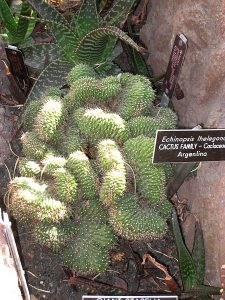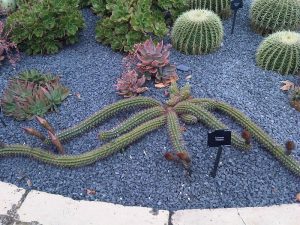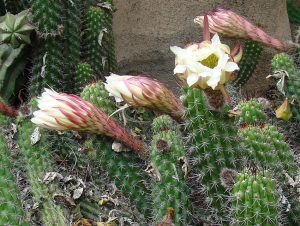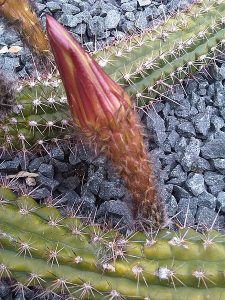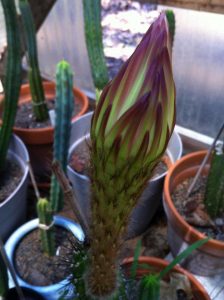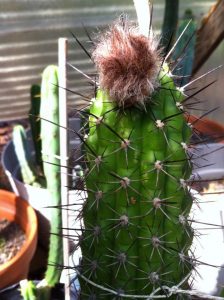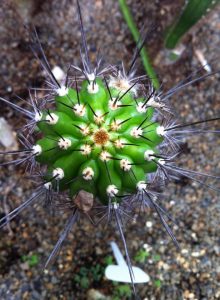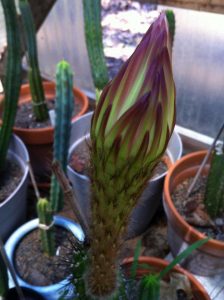Trichocereus Bridgesii (Echinopsis Lageniformis)
Trichocereus Bridgesii (SD.) Britton & Rose – The Cactaceae
C.F. Förster – H.Friedrich & GD Rowley 1974
CITES: Appendix II.
Origin: The Plant grows throughout Bolivia (LA PAZ, Chochabamba, Chuquisaca, Santa Cruz, Tarija and there might be areas in Peru where it grows as well. Intermediates are not really know but it´s very possible that there are some. 1000-3000 meters.
Synonyms: Cereus lageniformis, cereus bridgesii, trichocereus crassicostatus, Cereus bridgesii var. longispinus, Cereus bridgesii brevispinus, Cereus lasiacanthus, Trichocereus Boliviensis, Trichocereus Riomizquensis (some of them), uva.
Some of the Varieties on the market: KK919 Trichocereus Bridgesii, KK920 Trichocereus Bridgesii, Trichocereus Bridgesii Cristata, TBM type A, TBM type B, Lumberjack, Eileen, Jeans, Psycho0, TBM, Penis Plant, Penis Cactus, Frauenglück or Frauenglueck, Trichocereus Bridgesii var. Inermis, Eileen,and many more
Trichocereus bridgesii is now called Echinopsis lageniformis. It´s also called the Bolivian torch cactus and is a very fast growing columnar cactus from the high deserts of Bolivia. Despite its similar name, Trichocereus Bridgesii should not be confused with Echinopsis bridgesii, which is a clustering, Echinopsis type cactus growing around Bolivia. It its extremely drought tolerant and withstands colder temperatures than some other Trichocereus species. If you are new to cacti but want to grow one of the San Pedro type cacti, Trichocereus bridgesii is a perfect plant for you.
Among the indigenous inhabitants of Bolivia, it’s sometimes called Achuma or bolivian San Pedro cactus.
Healthy plants have a light green epidermis and between four to eight ribs. Spines can range in coloration from honey-coloured to brown, and are located at the nodes in groups of up to four. Chemical analysis of some forms of this species has revealed it may contain some mescaline.
It grows similar to a tree and reaches a size of up to 5 meters. The Species is not as glaucous as Trichocereus Peruvianus and Trichocereus Pachanoi and has a light green epidermis.
Trichocereus Bridgesii reaches up to 15 centimeters in diameter and large specimens are often confused with Trichocereus Peruvianus. The fact that very thick specimens can look a lot like Trichocereus Peruvianus is a reason that there are many misidentified specimens on the market. Some sellers even label them “SAN PEDRO”, “PERUVIAN TORCH” or “Trichocereus Peruvianus”, because they usually are more expensive as Trichocereus Bridgesii.
It has 4-8 Ribs and the Areoles are about 2 centimeters distanced of each other. Four-ribbed plants are sometimes called “Trichocereus of the four Winds”, though it´s actually a lot more common for this species to grow or lose a rib than you would think. A Trichocereus that grows a rib looks very much like it would put out monstrose growth. But yeah, they are justing getting more and more ribs the larger they get. Trichocereus Bridgesii has very broad furrows. The plant can reach up to 3-5 meters.
Spines: 4-6 needle-like, yellow Spines. Some of them are very uneven and vary greatly in length and appearance. Some large plants even lose their spines completely. This is something that we encountered a couple of times on larger plants and spineless Bridgesii´s look very much large hybrids between Trichocereus Peruvianus and Trichocereus Bridgesii.
Flower: Flowers are white and up to 20 centimeters long and 10 centimeters in diameter. Trichocereus Bridgesii is a night flowering species and its fruits are usually up to 5 centimeters long. It had white petals and small scales and hairs on the rest of the flower.
Typus location: Bolivia, La Paz
Trichocereus Bridgesii as Grafting Stock: Trichocereus bridgesii is an excellent grafting stock. However, there are some species that are even better for grafting. Nonetheless, it´s a strong and vigorously growing stock that will produce large scions very fast.
Forms:
The fact that most specimens look very similar, makes it pretty impossible to differentiate between the varieties. There are some known clones available but generally speaking, Trichocereus Bridgesii is the Trichocereus with the least variability, compared to other San Pedros. However, they have been used extensively in hybrid culture in the past ten years and there are many interesting hybrids out there that look like a mix between all kinds of Trichocereus species.
The monstrose form of Echinopsis lageniformis aka Trichocereus Bridgesii is called the Penis Plant or TBM. Contrary to the typical columnar habit of the species, this cultivar displays short stem segments that branch forming a small bush. The upper part of each stem section is smooth and spineless, resembling a certain male body part. The lower part shows a tendency to form ribs and is spiny. The plant is light green in color.
Cultivation: Trichocereus Bridgesii is one of the strongest growers in the genus Trichocereus or Echinopsis. It´s VERY drought resistant and much more unproblematic than other Trichos. Especially if you grow them from seed, because no matter what else you grow, they will be the ones to survive the longest if you suddenly “forget” to water them for a month or so. The come from Bolivia and live off very little water but also manage to compensate strong rainfalls and are rarely affected by fungal infections or mold. It´s a very thankful plant to grow, especially when you have the luck to plant them outside.
So cultivation is pretty easy. Don´t water them when it´s cold. It´s the same treatment that you would give any other Trichocereus. Only water them during the hot growth season in summer. If they are in full growth and the temperatures are high, they like to be watered weekly or sometimes even more often, but it depends on the growth medium. They don´t like soils that contains too much humus and i´d recommend to grow them in a purely mineral soil mix, with pumice, coarse sand and maybe a very little bit of standard cactus soil to make sure that they are able to take in the nutrients. Generally speaking, Trichocereus Bridgesii is the Archetype of a cactus that thrives on poor soils. I would not recommend to put them in full sun for the whole day but they can take much more sun that other Trichos that come from more tropical climates.
Winter treatment & frost tolerance: Trichocereus Bridgesii is able to tolerate mild frost. The minimum temperature should NOT exceed -8° Celsius though. That means 17.6° Fahrenheit is the limit. Trichocereus bridgesii usually has no problems to compensate light night frosts but the average minimum temperature should not be lower than 10° Celsius! That is around 50° fahrenheit. One important factor in frost resistance is the humidity of a soil! Plants should be totally dry in winter to make it easier for them to deal with frost. That´s why growers in Europe and other countries with strong frost have to take em inside in winter. They require a bright and well ventilated space with a temperature around 10° celsius. Not only ensure it that the plants soil system does not rot, it also promotes flowering!
Cultivation from seed:
Trichocereus Bridgesii is very easy to grow from seed. The seeds remain their viability for 5-10 years and some even longer. The best germination rate can be expected within the first year though. The seeds require light to germinate and you only sprinkle them on top of the soil. As a germination medium, I would recommend a mix between sowing soil and coarse sharp sand. This reduces your chance of contamination and/or Algae/Moss production. Moss and Algae are a real problem for cactus growers because they overgrow your seedlings and usually kill them. If you see green crap on your soil, thats what I am talking about. The seeds only need very little water to germinate, so dont overwater them in the beginning. You can always add more water but you can never take back a bad overwatering because it usually washes the seeds away or will lead to rotten seeds and soil. Germination temperature for Trichocereus Bridgesii or Echinopsis Lageniformis is around 25°-30° celsius. But be careful because small seedlings die very easily because of too much heat. Especially if you germinate in closed containers, temps can get quite high in there. The time needed for them to germinate is between 2-6 weeks. If nothing has germinated after that, it´s probably because a.) there wasnt enough water to kickstart the germination. In this case just add more water and wait some more. b.) the temperatures were not high enough. In this case, just increase the temps and continue to germinate. Or C.) The seed is dead. There are a couple black sheep in seed business who sell seed that´s between 10-20 years old and the viability is horrible. So if you did everything right and nothing germinated, it´s the seed. Seed quality on the market varies greatly and you never know what batch you will end up with. So if you had a batch batch, I´d recommend you to contact the seller and ask him about it. Stay friendly and polite and they will replace it because they are aware of the great differences in seed quality.
Trichocereus Bridgesii: Where to buy seed?
There are not many commercial sources for seed of Trichocereus bridgesii. I can recommend Köhres because their seed is usually fresh. Besides than that, I know of a Peruvian Seed Wholesaler who is selling Bridgesii seed but his seed is usually very inconsistent. Apart from commercial sources, there are people in our Trichocereus group on facebook who give away fresh seed every now and then. In most cases, this seed is the freshest because it comes directly from the growers. The domain name is facebook.com/groups/trichocereus
Besides, SAB is selling live cuttings and seeds every now and then. shaman-australis.com
And Sacred Succulents have a whole lot of crosses and live cuttings too! sacredsucculents.com
Propagation: Trichocereus Bridgesii can be grown from seed pretty easily. But you can also take cuttings and re-root them. This way, you can multiply your plants dramatically and if you are trying to get a lot of plants, you can also try areole grafting. Trichocereus Bridgesii is pretty tough and you can basically stick it in a dry medium like sand and it will probably grow. Just make sure to let the cuts dry out and give the wound enough fresh air until everything is calloused. I use bird sand for that purpose, which is the mineral soil mix that you get in pet stores for the birds to take their dump in. It contains anise and some other minerals that just prevent mold and infections and it is perfect for rooting plants in it.
USDA Zones: 10a, 10B and 11
Purposes: Can be used as grafting stock or just because its´an amazing cactus. Besides, Trichocereus Bridgesii is used as natural fence to keep away animals and people.





This is a Herbarium Sample of Trichocereus Bridgesii! Pic: Ben Kamm, Sacredsucculents.com:


Peter A. Mansfeld – Trichocereus Bridgesii Monstrose B, Penis Plant

Bild: Codify from Perth

Fat bridgesii “LUMBERJACK” from Misplant.net


 Melty Crest – Pic by Mutant
Melty Crest – Pic by Mutant


Bridgesii Monstrosa Inermis
This One came labeled Trichocereus Bridgesii Inermis, which stands for “Spineless”. Typical Bridgesii Monstrose.
Trichocereus Bridgesii (Echinopsis Lageniformis)
